Main menu
Common skin conditions

NEWS
Join DermNet PRO
Read more
Quick links
Contact dermatitis
Created 2008.
Learning objectives
- Identify and manage contact dermatitis
Clinical features
Contact dermatitis is an eczematous response to material in direct contact with the skin.
Irritant contact dermatitis
Irritant contact dermatitis arises when the skin is exposed acutely or chronically to chemical or physical agents that irritate the skin. Irritant hand dermatitis is very prevalent in certain occupations such as cleaning and hairdressing, especially in atopic subjects. In infants, irritant dermatitis includes napkin dermatitis and dribble rash. Irritant reactions include:
- Transient stinging, burning and erythema (especially on the face)
- Acute chemical burns
- Acute dermatitis, frequently with a glazed surface and sharp borders
- Chronic dermatitis, with ill-defined border and lichenification.
Typical irritants include friction and abrasion, water, dry and/or cold air, detergents, solvents, acids and alkalis, oxidising and reducing agents, prickly plants, enzymes, dirt, urine and many other substances.
Irritant dermatitis occurs at the site of direct injury to the cells. Gradual onset of dermatitis arises from loss of the skin barrier and inadequate repair mechanisms. It can be confused with or coexist with allergic contact dermatitis.
Irritant contact dermatitis
Benzoyl peroxide reaction Dribble rash Napkin dermatitis 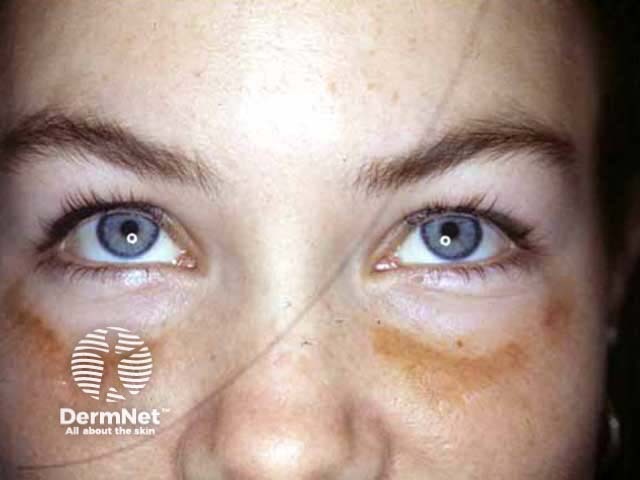
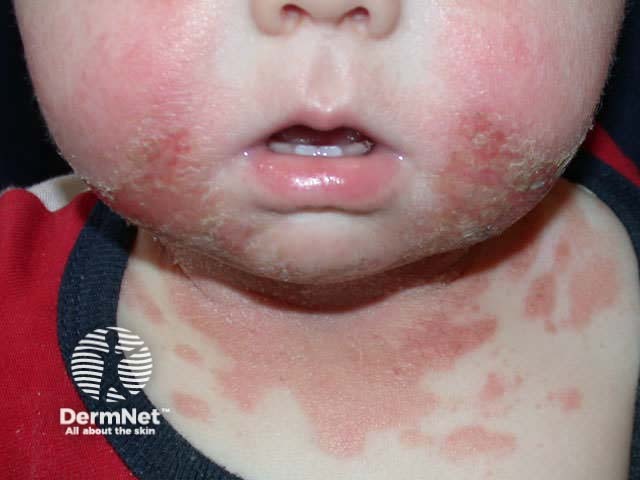

Allergic contact dermatitis
Allergic contact dermatitis refers to cutaneous delayed hypersensitivity reactions and may be confirmed by patch testing. The dermatitis may be acute, subacute, chronic or relapsing and may coexist with another form of dermatitis.
The pattern of distribution may give a clue to the origin, but although it may initially be confined to sites of contact the dermatitis may spread or generalise. Very small amounts of the allergen may be sufficient to cause dermatitis in sensitised individuals.
Allergic contact dermatitis refers to cutaneous delayed hypersensitivity reactions and may be confirmed by epicutaneous patch testing. The dermatitis may be acute, subacute, chronic or relapsing and may coexist with another form of dermatitis.
The pattern of distribution may give a clue to the origin, but although it may initially be confined to sites of contact the dermatitis may spread or generalise. Very small amounts of the allergen may be sufficient to cause dermatitis in sensitised individuals.
Contact allergy

Shoe dermatitis
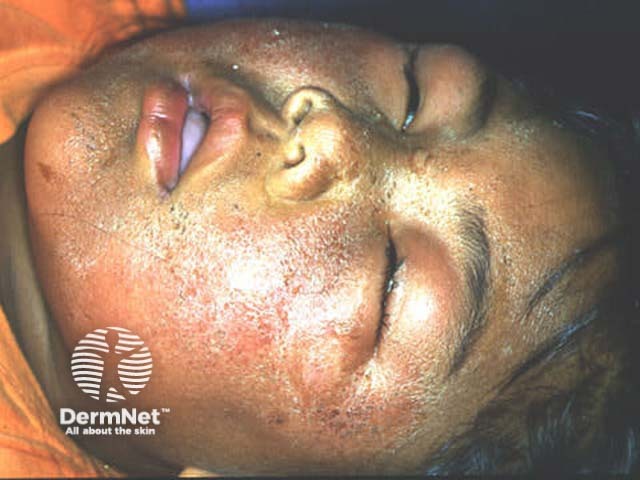
Plant dermatitis
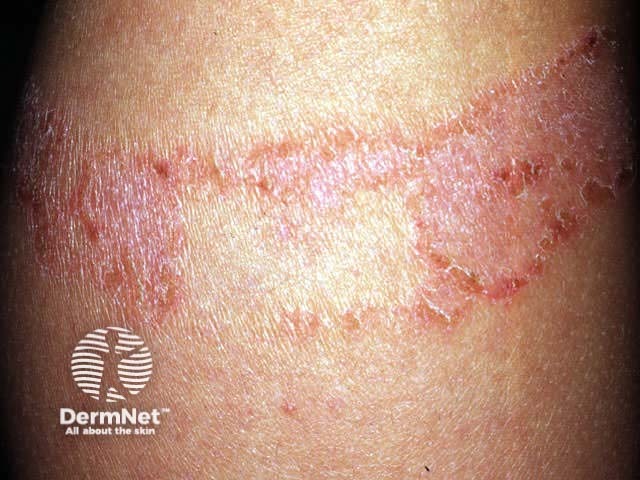
Adhesive plaster dermatitis
Some examples of contact allergy:
- Plant allergy (e.g. toxicodendron) may give rise to linear blisters and oedema on exposed sites
- Metal allergy is not uncommon in children and affects 10% adult females (nickel). It may cause dermatitis on earlobes (earrings), neck (chain), wrist (watch strap) and lower abdomen (jeans stud).
- Perfume or preservative allergy may cause dermatitis in axillae (deodorant), face (moisturiser) or hands (numerous household products)
- Footwear allergy (e.g. chrome used to tan leather, adhesive used in shoes, rubber) presents as a rash confined to the feet
- Medicament allergy (e.g. neomycin ointment) occurs where the ointment has been applied
- Rubber antioxidant allergy (e.g. thiuram in rubber gloves) causes or aggravates chronic hand dermatitis. Latex can cause immediate hypersensitivity reactions resulting in contact urticaria or rarely anaphylaxis. In children, it most often arises in the context of spina bifida.
Investigations
Patch tests Dermatologists use epicutaneous patch tests to identify contact allergens but interpretation of the results requires considerable experience. The standard series of about 24 common contact allergens may be supplemented by numerous other known or suspected compounds in low concentration. The test substances are applied to small plastic or aluminium chambers on special non-allergic tape. The patches are applied to the upper back and removed after 48 hours. The skin is observed over at least the next 48 hours. Eczematous reactions suggest contact allergy but may also be irritant in nature (non-allergic), especially in atopic subjects, and detected allergy may not be relevant to the presenting complaint.
The most common contact allergens include nickel, cobalt and chrome, fragrances, various anti-oxidant compounds used in the manufacture of rubber, preservatives and adhesives.
Patch tests
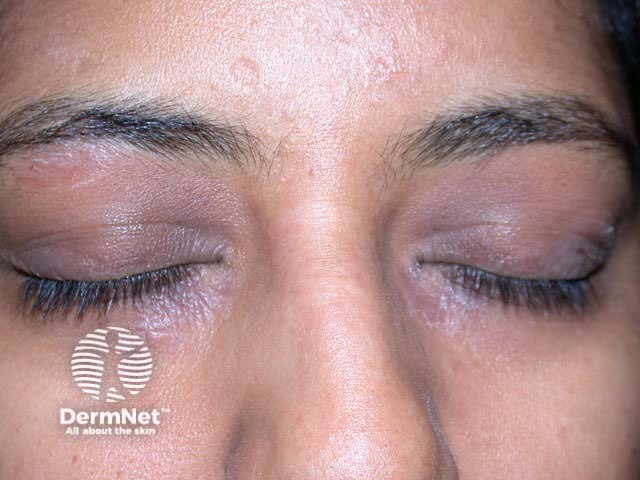
Eyelid dermatitis of unknown cause
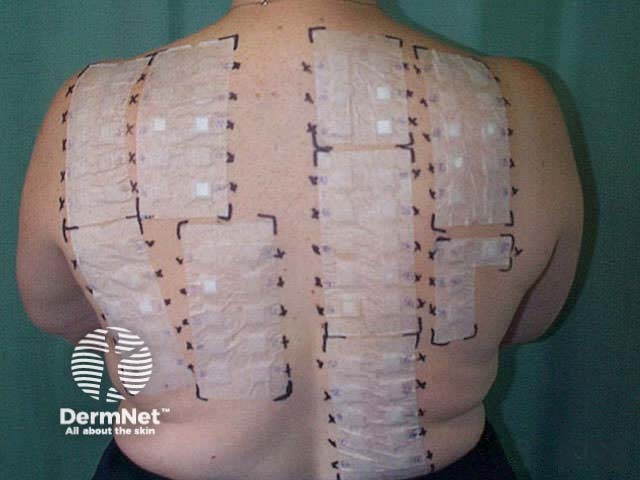
Patch tests to standard series, preservatives and fragrances
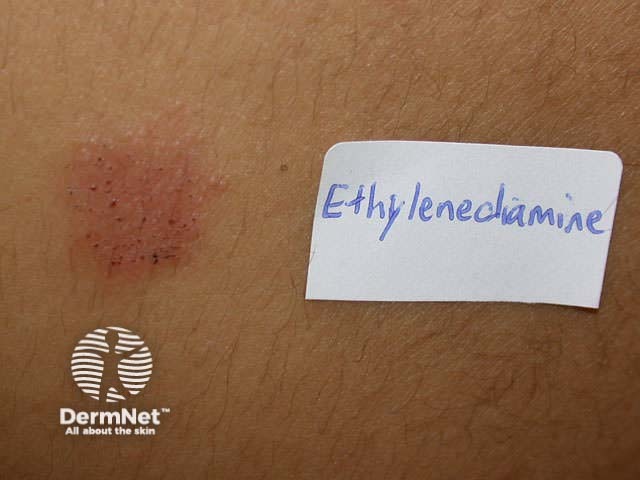
Positive patch test to ethylenediamine, present in a cream the patient was applying to itchy patches
Management
Management of contact dermatitis involves:
- Protection from further exposure to irritants and known allergens
- Emollient barrier cream before, during and after exposure to irritants
- Topical corticosteroids
- Antibiotics for secondary infection
- In chronic cases, patch testing to identify contact allergies.
Activity
List the most common plants to cause irritant contact dermatitis, allergic contact dermatitis and phytophotodermatitis.
References:
On DermNet:
Information for patients
Other websites:
- Medscape Reference:
- Merck Medicus Best Practice of Medicine: Contact dermatitis
Books about skin diseases:
See the DermNet bookstore
